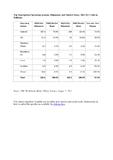.2013 – Despite beating Wall Street expectations in terms of shipment volumes, Apple-s share in the worldwide smartphone operating system market posted a year-over-year decline during the second quarter of 2013 (2Q13). Meanwhile, Android and Windows Phone both managed slight increases during the same period. According to the International Data Corporation (IDC) Worldwide Quarterly Mobile Phone Tracker, vendors shipped a total of 236.4 million smartphones in 2Q13, up 51.3% from the 156.2 million units shipped in 2Q12. Second quarter shipments grew 9.3% when compared to the 216.3 million units shipped in 1Q13.
“The iOS decline in the second quarter aligns with the cyclicality of iPhone,” says Ramon Llamas, Research Manager with IDC-s Mobile Phone team. “Without a new product launch since the debut of the iPhone 5 nearly a year ago, Apple-s market share was vulnerable to product launches from the competition. But with a new iPhone and revamped iOS coming out later this year, Apple is well-positioned to re-capture market share.”
“Last quarter we witnessed Windows Phone shipments surpassing BlackBerry and the trend has continued into the second quarter,” said Ryan Reith, Program Manager with IDC-s Mobility Tracker Programs. “Nokia has clearly been the driving force behind the Windows Phone platform and we expect that to continue. However, as more and more vendors enter the smartphone market using the Android platform, we expect Windows Phone to become a more attractive differentiator in this very competitive market segment.”
Smartphone Operating System Highlights
Android maintained its leadership position, with strong contributions from Samsung and its Galaxy S4. Not to be overlooked were LG and Chinese vendors Huawei, Lenovo, and ZTE, which each recorded double-digit shipment volumes in the millions. Combined, these vendors accounted for 62.5% of all Android-powered smartphone shipments during the quarter. Still, the remaining vendors within the Android ecosystem should not be overlooked, as many have developed a strong local presence within key developing markets.
iOS finished the quarter as the clear number 2 operating system, showing that, even without new product launches, demand remains strong. Moreover, Apple added new mobile operators to its camp, boosting short-term volumes and cementing long-term end-user relationships. What remains to be seen is how the new iOS 7 will be received once it reaches the market later this year, as much of the look and feel of the user interface has been revamped.
Windows Phone posted the largest year-over-year increase among the top five smartphone platforms, and in the process reinforced its position as the number 3 smartphone operating system. Driving this result was Nokia, which released two new smartphones and grew its presence at multiple mobile operators. But beyond Nokia, Windows Phone remained a secondary option for other vendors, many of which have concentrated on Android. By comparison, Nokia accounted for 81.6% of all Windows Phone smartphone shipments during 2Q13.
BlackBerry saw its market share decline during the quarter, reaching levels not seen in the history of IDC-s Mobile Phone Tracker. However, BlackBerry has shown steady progress since the launch of its BB 10 platform, which has grown to three models, additional mobile operators, and a greater presence within its total volumes. It is still early days for the platform, however, and BlackBerry will need time and resources to evangelize more end users.
Linux, with few vendors supporting the open source platform and virtually no global presence, barely scraped together a single percentage point of market share during the quarter. Most vendors have transitioned to Android and those that remain have limited presence within specific markets. It should be noted that IDC includes Linux-branded shipments in these numbers, and excludes Android-branded shipments. Several other branded variations of Linux, including Firefox, Tizen, and SailFish, are expected to launch later this year, providing a potential boost to volumes and market share.
About IDC Trackers
IDC Tracker products provide accurate and timely market size, vendor share, and forecasts for hundreds of technology markets from more than 100 countries around the globe. Using proprietary tools and research processes, IDC-s Trackers are updated on a semiannual, quarterly, and monthly basis. Tracker results are delivered to clients in user-friendly excel deliverables and on-line query tools. The IDC Tracker Charts app allows users to view data charts from the most recent IDC Tracker products on their iPhone and iPad.
For more information about IDC-s Worldwide Quarterly Mobile Phone Tracker, please contact Kathy Nagamine at 650-350-6423 or knagamine@idc.com.
IDC is the premier global provider of market intelligence, advisory services, and events for the information technology, telecommunications, and consumer technology markets. IDC helps IT professionals, business executives, and the investment community to make fact-based decisions on technology purchases and business strategy. More than 1,000 IDC analysts provide global, regional, and local expertise on technology and industry opportunities and trends in over 110 countries worldwide. For more than 49 years, IDC has provided strategic insights to help our clients achieve their key business objectives. IDC is a subsidiary of IDG, the world-s leading technology media, research, and events company. You can learn more about IDC by visiting www.idc.com.
Companies Covered:
ZTE Corporation, Apple Inc., Lenovo Group Limited, Huawei Technologies Co., Ltd., LG Corp., Nokia Corporation, HTC Corporation, Samsung
Regions Covered:
United States
Topics Covered:
Android, BlackBerry, Linux, Mobile platform, Smartphone, Symbian, Windows Phone 7, iOS


You must be logged in to post a comment Login